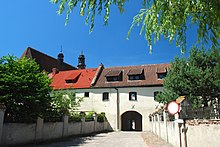Zuckau Monastery
The Zuckau Monastery (also Sukow or Suckow ) was a monastery of the female branch of the Premonstratensian Order , which was located in Zuckau (today in Polish: Żukowo ) near Danzig until 1834 . The village of Zuckau used to belong to the Karthaus district in the Prussian province of West Prussia .
history
The monastery was probably founded and built at the beginning of the 13th century. In 1201 Pope Innocent III confirmed . the canons of the Premonstratensian Monastery of St. Vinzenz zu Breslau owned the Jakobikirche zu Zuckau, among other things. The year of foundation of the Zuckau nunnery is usually assumed to be 1209, as the Gdańsk Prince Mestwin I assigned the Premonstratensians a place to build a monastery near the village at that time and furnished the foundation with extensive property. The first monastery complex was located near the mouth of the Stolpe river in the Radaune . At the instigation of Abbot Alardus the Wrocław St. Vincent Pen, who until 1214 in office, the first nuns came from at Hohensalza nearby monastery Strzelno . In 1224 the monastery was destroyed when the Pomesanians invaded and the inmates were killed. Around this time the monastery was moved to Zuckau itself. It is not known exactly where it was last in Zuckau.
The daughters of Pomeranian aristocrats and Danzig patrician families, as well as several members of the Pomeranian ducal house, have found accommodation in the Zuckau Monastery. On May 25, 1223, the daughter of a Swantopolk , who had founded the church in Chmielno and gave this village and several other villages to the monastery, died in Zuckau Damroka monastery when she herself entered the monastery. Already in 1224 the lands and possessions of the monastery included both the Brodno Lake and the Gartsno Lake (northwestern branch of the Radaunese lake ) in the region around Chmelno . Duke Mestwin II of East Pomerania later confirmed the immunity of the monastery from the jurisdiction of sovereign officials, the possession of the property locations acquired over time and approved their reassignment to German law. In 1260 the Pomeranian Duke Swantopolk II granted the monastery market rights and left it to him to develop the village into a town. However, this plan did not materialize.
In 1433, marauding Hussites who passed through caused severe damage to the monastery through arson and robbery. In 1443 the refectory was still without a roof. When the monastery, which was originally designed to accommodate 60 nuns, asked the Teutonic Order for help, it made it a condition for the nuns to convert to the rule of the Teutonic Order. The nuns then turned to the Pope, who approved the conversion, and had been sisters of the Teutonic Order since 1445. The Pope forbade the Premonstratensian abbot to visit the monastery in the future.
In 1564 the Lauenburg governor Ernst von Weiher, the older brother of the Camminer bishop Martin von Weiher , bought the Charbrow , Labenz and Ossecken estates , which had previously belonged to the Zuckau monastery, from the Włocławek bishop Jakub Uchański for 12,000 thalers . In 1286 , Duke Mestwin II donated the village of Charbrow to the Kujavian cathedral chapter.
By 1600 the buildings of the monastery had become dilapidated and extensive repairs had been carried out since 1604. In 1661 it was recorded that the monastery "apprenticed children of good people", both noble and middle-class, whom it taught "in addition to the fear of the Lord to write, read and sew"; In addition to a girls 'school, there was also a boys' school.
In 1834 the monastery was closed. From 1836 the monastery church was used as a parish church. Part of the monastery complex was sold for demolition in 1863.
literature
- Ernst Bahr: Zuckau . In: Handbook of historical sites , East and West Prussia , Kröner, Stuttgart 1981, ISBN 3-520-31701-X , p. 247.
- Theodor Hirsch : The Zuckau Monastery and its surroundings during the 13th and 14th centuries . In: New Prussian Provincial Papers . Volume 3 (born 1853, January – June), Königsberg 1853, pp. 4–71 ( online version )
- Max Perlbach : The Book of the Dead of the Premonstratensian Monastery of Zuckau near Danzig , 1906.
Footnotes
- ↑ a b c d e Ernst Bahr: Zuckau . In: Handbook of historical sites , East and West Prussia , Kröner, Stuttgart 1981, ISBN 3-520-31701-X , p. 247.
- ^ Theodor Hirsch : The Zuckau Monastery and its surroundings during the 13th and 14th centuries . In: New Prussian Provincial Papers . Volume 3 (born 1853, January – June), Königsberg 1853, pp. 4–71 ( online version )
- ↑ Archived copy ( Memento of the original from May 14, 2008 in the Internet Archive ) Info: The archive link was inserted automatically and has not yet been checked. Please check the original and archive link according to the instructions and then remove this notice.
- ^ Herbert Helbig and Lorenz Weinreich: Diplomata et chronica historiam locationis Teutonicorum illustranta , 1968.
- ^ August von Kotzebue : Prussia's older history . Volume 4, Riga 1808, p. 373 .
- ↑ Reinhold Cramer: History of the Lande Lauenburg and Bütow . Part I, Königsberg 1858, p. 183 .
- ↑ Johann Jakob Sell : History of the Duchy of Pomerania from the earliest times to the death of the last duke, or to the Peace of Westphalia . 1. Part, Berlin 1819, pp. 349-350, footnote b) .



